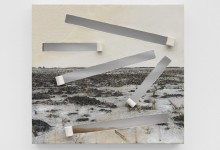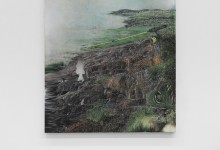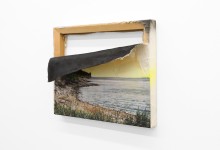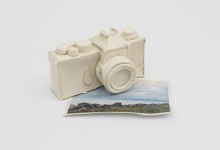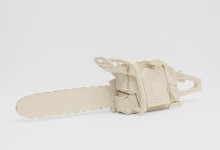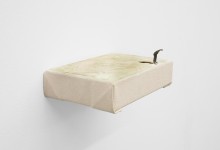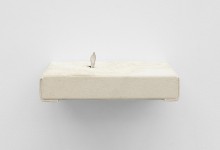Reception: Saturday, January 13, 2024 from 3 p.m. to 5 p.m.
Éric Lamontagne: The nature of silent things
Text by Rebecca Johnson
When creating his artworks, Éric Lamontagne begins by painting a landscape scene, often with a body of water or cliffs. He then carefully cuts, folds, rips, and slashes the canvas both to produce elements that protrude out from the painted scene and to create holes and gaps in it. Lamontagne challenges the painting process by experimenting with the materiality of the canvas as well as the application of paint with tactful techniques. In some paintings, certain segments of the canvases are left raw or only glazed, whereas in others, there are sections where the paint appears pixelated or melted. His practice confuses what we know about painting, while it also confuses our perception of the natural world.
Lamontagne’s interventions are almost aways directly and inherently connected to human presence. He strategically indexes how humans impose themselves into the environment by including everyday objects, such as the three-dimensional tire or suitcase cut-outs in se transporter ailleurs. The artist, however, also conveys this commentary through more abstract ideas, such as puncturing a canvas of a serene landscape with a massive hole, as seen in le trou. In his paintings, these obtrusions and removals are simultaneously distinct, or separate, from the landscape, while at the same time, they are integral and indivisible components.
In cage aux îles, the artist methodically cuts out neat little squares from an otherwise picturesque seascape of a quaint fishing town. He then neatly rolls the canvas tightly into itself and paints them as cigarette butts. Segments of canvas that are necessary to complete the scene’s vista are removed, insinuating both absence and destruction. The trompe-l’oeil cigarettes – some lit, others bent, and others only half smoked – litter not just the ground, but the entirety of the scene. Here, the artist interjects into the landscape in a similar destructive manner that we as humans have intervened into the natural world.
Several artworks in this exhibition showcase what Lamontagne has referred to as a “marvellous dump,” that is, the compilation of various objects organized in a surreal and playful way. The “marvellous” encompasses the sense of whimsy and play achieved by rendering these objects in a different scale than their landscape or by allowing them to interact in unrealistic ways. While at the same time, the concept of “dump” calls directly to a conscious consideration of the damaging impact we have on our environment as we leave behind our traces. In its essence, Lamontagne’s works capture feelings of unknowing, or even uneasiness, that we may have towards the environment and our place within it.
The artist would like to thank the Canada Council for the Arts for their support.



